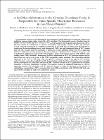| dc.contributor.author | SULLIVAN, DEREK | en |
| dc.contributor.author | COLEMAN, DAVID | en |
| dc.contributor.author | MORAN, GARY | en |
| dc.contributor.author | MCMANUS, BRENDA ANN | en |
| dc.date.accessioned | 2010-06-22T16:10:21Z | |
| dc.date.available | 2010-06-22T16:10:21Z | |
| dc.date.issued | 2009 | en |
| dc.date.submitted | 2009 | en |
| dc.identifier.citation | McMANUS BA, MORAN GP, HIGGINS JA, SULLIVAN DJ, AND COLEMAN, DC, A Ser29Leu SUBSTITUTION IN THE CYTOSINE DEAMINASE Fca1p IS RESPONSIBLE FOR CLADE-SPECIFIC 5-FLUCYTOSINE RESISTANCE IN Candida dubliniensis, ANTIMICROBIAL AGENTS AND CHEMOTHERAPY, 53, 2009, 4678 - 4685 | en |
| dc.identifier.other | Y | en |
| dc.identifier.uri | http://hdl.handle.net/2262/40202 | |
| dc.description | PUBLISHED | en |
| dc.description | August 24; Epub ahead of print | en |
| dc.description.abstract | The population structure of the opportunistic yeast pathogen Candida dubliniensis is composed of three main multilocus sequence typing clades (clades C1 to C3), and clade C3 predominantly consists of isolates from the Middle East that exhibit high-level resistance (MIC(50) > or = 128 microg/ml) to the fungicidal agent flucytosine (5FC). The close relative of C. dubliniensis, C. albicans, also exhibits clade-specific resistance to 5FC, and resistance is most commonly mediated by an Arg101Cys substitution in the FUR1 gene encoding uracil phosphoribosyltransferase. Broth microdilution assays with fluorouracil (5FU), the toxic deaminated form of 5FC, showed that both 5FC-resistant and 5FC-susceptible C. dubliniensis isolates exhibited similar 5FU MICs, suggesting that the C. dubliniensis cytosine deaminase (Fca1p) encoded by C. dubliniensis FCA1 (CdFCA1) may play a role in mediating C. dubliniensis clade-specific 5FC resistance. Amino acid sequence analysis of the CdFCA1 open reading frame (ORF) identified a homozygous Ser29Leu substitution in all 12 5FC-resistant isolates investigated which was not present in any of the 9 5FC-susceptible isolates examined. The tetracycline-inducible expression of the CdFCA1 ORF from a 5FC-susceptible C. dubliniensis isolate in two separate 5FC-resistant clade C3 isolates restored susceptibility to 5FC, demonstrating that the Ser29Leu substitution was responsible for the clade-specific 5FC resistance and that the 5FC resistance encoded by FCA1 genes with the Ser29Leu transition is recessive. Quantitative real-time PCR analysis showed no significant difference in CdFCA1 expression between 5FC-susceptible and 5FC-resistant isolates in either the presence or the absence of subinhibitory concentrations of 5FC, suggesting that the Ser29Leu substitution in the CdFCA1 ORF is the sole cause of 5FC resistance in clade C3 C. dubliniensis isolates. | en |
| dc.format.extent | 4678 | en |
| dc.format.extent | 4685 | en |
| dc.language.iso | en | en |
| dc.relation.ispartofseries | ANTIMICROBIAL AGENTS AND CHEMOTHERAPY | en |
| dc.relation.ispartofseries | 53 | en |
| dc.rights | Y | en |
| dc.subject | Dental Science | en |
| dc.subject | Microbiology | en |
| dc.subject | Candida dubliniensis | en |
| dc.title | A Ser29Leu SUBSTITUTION IN THE CYTOSINE DEAMINASE Fca1p IS RESPONSIBLE FOR CLADE-SPECIFIC 5-FLUCYTOSINE RESISTANCE IN Candida dubliniensis | en |
| dc.type | Journal Article | en |
| dc.type.supercollection | scholarly_publications | en |
| dc.type.supercollection | refereed_publications | en |
| dc.identifier.peoplefinderurl | http://people.tcd.ie/djsullvn | en |
| dc.identifier.peoplefinderurl | http://people.tcd.ie/gmoran | en |
| dc.identifier.peoplefinderurl | http://people.tcd.ie/dcoleman | en |
| dc.identifier.rssinternalid | 60667 | en |
| dc.identifier.doi | http://dx.doi.org/10.1128/AAC.00607-09 | en |
| dc.subject.TCDTheme | Genes & Society | en |
| dc.subject.TCDTheme | Immunology, Inflammation & Infection | en |
| dc.identifier.rssuri | http://www.ncbi.nlm.nih.gov/entrez/query.fcgi?cmd=Retrieve&db=PubMed&list_uids=19704126&dopt=Abstract | en |
| dc.identifier.orcid_id | 0000-0003-0195-9697 | en |




